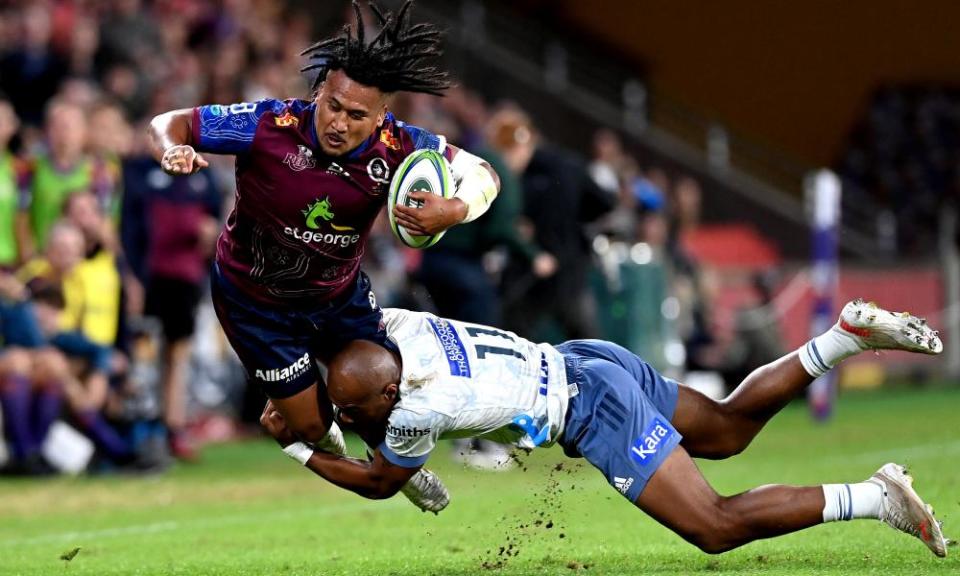Australia needs New Zealand in rugby union’s battle to stay relevant

Only days after the Super Rugby Trans-Tasman final between the Blues and the Highlanders in Auckland, the future of the southern hemisphere’s elite provincial rugby competition remains uncertain.
As focus shifts to the Test arena and the Wallabies’ upcoming series against France, Australia and New Zealand have only a few months to determine the Super Rugby format for next year and beyond.
Related: Waratahs in crisis: how did it all go so horribly wrong for NSW? | Bret Harris
There appears to be a strong appetite in Australia for the continuance of the domestic Super Rugby AU and Super Rugby Aotearoa competitions, although not so much in New Zealand.
No doubt, there was a feel-good aspect to Australian teams winning each week in their own domestic competition, which culminated in the Queensland Reds’ 19-16 victory over the Brumbies in the final in front of 42,000 spectators at Suncorp Stadium.
It is hard to argue with that many fans, but the reality was there were only three high-standard games in Super Rugby AU – the two regular season games between the Brumbies and the Reds and the final.
The closeness of many of the games camouflaged the fact that the general standard of play was not that high, something that was subsequently exposed in Super Rugby Trans-Tasman.
All the goodwill the Australian teams generated in Super Rugby AU virtually vanished when they managed to win just two of 25 games against Kiwi opposition in the Trans-Tasman series with the Brumbies and Reds winning one game each. None of Australia’s other three teams – the Melbourne Rebels, NSW Waratahs and Western Force – won a single game between them.
It was predictable that New Zealand’s five teams would finish above Australia’s five teams and that the final would be contested by two Kiwi sides, although there was hope the Brumbies and Reds might be more competitive than they were.
Download the Guardian app from the iOS App Store on iPhones or the Google Play store on Android phones by searching for 'The Guardian'.
If you already have the Guardian app, make sure you’re on the most recent version.
In the Guardian app, tap the yellow button at the bottom right, then go to Settings (the gear icon), then Notifications.
Turn on sport notifications.
Some observers believe the Australian teams should play in splendid isolation and avoid the dominant Kiwis, but this would not be sustainable from a commercial or high-performance point of view.
A five-team Australian competition would not provide enough content for broadcasters and sponsors, while doubling the number of rounds would be too repetitive. Australia could look to add more teams, but the country’s playing resources are already stretched to the limit.
The longer Australian teams played on their own, the further playing standards in Australia would fall. The reality is Australia needs New Zealand, but the scheduling of two domestic competitions followed by a trans-Tasman crossover series is not ideal.
Australian rugby fans used to complain when their Super Rugby team disappeared in South Africa for two weeks, extending the gap between home games, but the situation was worse in the current set-up.
By the time the Brumbies hosted their first home game in Trans-Tasman a whole six weeks had elapsed since they last played in Canberra in the Super Rugby AU qualifying final. It does not make any sense for teams to lose touch with their fans for such a long period of time.
It would much better to dovetail Super Rugby AU and Super Rugby Aotearoa into a full home-and-away trans-Tasman competition with the possible addition of two Pacific Island teams or a side from Japan to create variety.
The Australian teams could still compete for the Super Rugby AU title within the trans-Tasman competition in the same way the home nations – England, Ireland, Scotland and Wales – strive for the Triple Crown within the larger Six Nations tournament.
If an Australian team did not win the trans-Tasman competition, they could still win the Super Rugby AU title, played concurrently.
This would create one continuous, all-encompassing Super Rugby competition with home and away matches every week, while at the same time maintaining local interest in the performance of the Australian and New Zealand teams against their own.
Whatever Super Rugby format is agreed upon, it is highly likely New Zealand teams will remain superior for the foreseeable future, but that should be seen as the answer to Australia’s problems, not the cause.
If Australia wants to close the trans-Tasman gap and regain its place among the top nations of world rugby, the Australian sides must continue to play the Kiwis to improve their standards, not shy away from the challenge.
Australia needs to have a long, hard think about how it can make its Super Rugby sides competitive with the Kiwis again. If it is to persist with five Super Rugby teams, which seems at least one too many, it must re-asses every aspect of the game from coaching to strength and conditioning to pathways and recruitment to bridge the gap with New Zealand.
The physical intensity displayed in the Blues’ 23-15 win against the Highlanders in the final last Saturday was a level above Australian Super Rugby and a warning to the Wallabies of what to expect from the All Blacks in the Bledisloe Cup series.
No wonder coach Dave Rennie exhorted the Wallabies to discover their “dark side.” They will need it.

 Yahoo Sport
Yahoo Sport 





































